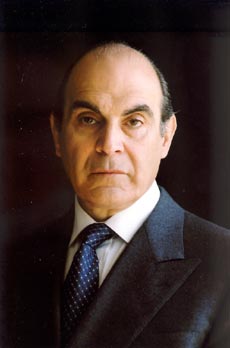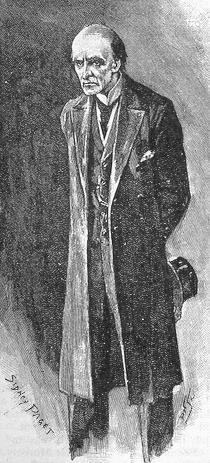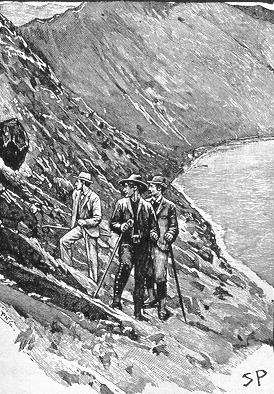دوستان هولمز دوست که کتابهاشو خوندن حتما با نام مرحوم
کریم امامی با اون ترجمه شیرینش آشنا هستند.مصاحبه زیر به گفته خود مصاحبه کننده،آخرین مصاحبه مرحوم امامی بوده....
---------------------------------------------------------------------------------------------------------
مصاحبه ای که سال 83 با کریم امامی فقید انجام دادم گمانم آخرین مصاحبه او بوده باشد .
( و آخرین عکس های حضرت امامی را هم رضا خنکدار گرفت )
گفتگو در یک روز بسیار سرد در یکی از اتاق های دفتر خانم امامی انجام شد . یکی دو ساعت درباره شرلوک هولمز گپ زدیم ؛ بازی جرمی برت را ندیده بود و به خودم قول دادم یک نسخه آبرومند از هولمز بی بی سی پیدا کنم و برایش ببرم . بعد آن دیدار خیلی زود به دیار باقی رفت .حسرتش به دلم مانده که چرا برای وفا به عهدم نجنبیدم .
این هم آخرین مصاحبه امامی فقید :
... همه مىگفتند آقاى امامى اهل مصاحبه نيست، اصلاً فرصت اين كارها را ندارد. كمى عجيب بود كه وقتى با ايشان تماس گرفتم، به سرعت قرار مصاحبه را گذاشتيم.
پيش از مصاحبه آقاى امامى كمى نگران بود و گفت اميدوار است مجبور نشود درباره زندگينامه كانن دويل و همه آن چيزهايى كه در كتابها پيدا مىشود، صحبت كند.
سعى كردم به ايشان اطمينان بدهم كه خودم يك هولمزباز اساسىام و چندان جاى نگرانى نيست. پس تلاش كردم درباره چيزهايى بپرسم كه در كتابها پيدا نمىشود.
با اين حال رفقاى من درباره گرفتارى و اشتغال آقاى امامى درست مىگفتند... چون موقع خداحافظى خيلى آرام و محرمانه گفت: چاره نبود، به خاطر هولمز بايد قبول مىكردم!
برگرديم به سالهاى دور، به آشنايى شما با شرلوك هولمز...
در دوره دبيرستان بود كه انگليسى مىخواندم و خوب هم مىخواندم چون علاوه بر دبيرستان به كلاسهاى شوراى فرهنگى بريتانيا در شيراز هم مىرفتم كه كلاسهاى درجه يكى بود و كتابخانه خوبى هم داشتند، انواع كتابهاى داستانى و غيرداستانى، به زبان ساده و غيرساده آنجا پيدا مىشد و با آن كتابخانه من كتابخوان شدم. و در همان كتابخانه شروع كردم به خواندن كتابهاى كانن دويل به زبان انگليسى و لذت بردن. وقتى به عنوان مترجم كار تجربه را آغاز كردم، سراغ داستانهاى شرلوك هولمز رفتم كه يكىاش همان قصه «ياقوت كبود» بود (كه ترجمه شد اما چاپ نشد). وقتى جسارت و جرأتم بيشتر شد كتاب «داستان چهار» را ترجمه كردم (آن روزها ديگر در دانشگاه بودم). حتى دادمش به ناشرى به نام معرفت. آقاى معرفت پايين خيابان لالهزار يك كتابفروشى هم داشت، كتاب را گرفت و گفت: «من چاپ مىكنم و جاى حقالتحرير 10درصد تيراژ را كتاب مىدهم.» مىخواست كتاب را در 1000 نسخه چاپ كند كه اگر چاپ مىشد من صاحب 100 نسخه كتاب مىشدم خلاصه يك سال طول كشيد و كتاب را چاپ نكرد. رفتم سراغش و گفتم «چى شد آقاى معرفت؟» گفت: «نشد و چاپ نكرديم و...» و من ترجمه را پس گرفتم و گذاشتم تو كشوم.
زندگى ادامه يافت و من به كارهاى مختلفى پرداختم، پس از انقلاب بود كه برخى ناشران متمايل شدند باز ترجمه هاى تازهاى از داستانهاى شرلوك هولمز چاپ كنند. به يكى از ناشران گفتم من چنين ترجمهاى دارم، اظهار علاقه كرد كه آن را چاپ كند. برگشتم سراغ ترجمه كه خوشبختانه حفظ شده بود (و گمان مىكنم نسخه دستنويسش را هنوز در دفترى دارم(.
ديدم ترجمه چندان اشكالى ندارد ولى زبانش را اصلاً نمىپسنديدم. ديدم اگر بنا باشد آن را به ناشر بدهم بايد سر تا پايش را بازنويسى كنم اين بود كه از چاپش منصرف شدم.
چند سال گذشت تا اينكه اين بار بالاخره آقاى پايا( مديرانتشارات طرح نو) با من صحبت كرد كه تعدادى از داستانهاى كوتاه هولمز را برايشان ترجمه كنم و حاصل شد اين چهار جلد كه تاكنون 2 بار چاپ شده...
خب، بحث را همين جا نگه داريم، تا بپرسم: نظرتان درباره ترجمه هاى ديگران از قصه هاى هولمز چيست؟ چه نسخه هاى سالهاى نوجوانىتان و چه برگردانهاى اخير...
اول اينكه من چون اصلشان را مىخواندم چندان به خواندن ترجمه ها راغب نبودم و اگر مىخواندم از سر كنجكاوى بود. در مورد ترجمه هاى قديمى شرلوك هولمز كه در ليست كتابشناسىها هست، حقيقتاً در دوره جوانىام به هيچ كدامشان برنخوردم. اما با مرور فهرست اين ترجمه ها مىبينم كه مجيد مسعودى، 5 جلد از اين كتابها را ترجمه كرده و مىدانم كه او مترجم قابل توجهى بوده كه دوره آخر عمرش را هم در BBC لندن كار مىكرد. بنابراين احتمالاً مىتوان آثار او را جدى گرفت.
بعد از انقلاب هم ترجمه هاى مختلفى از قصه هاى هولمز منتشر شد، كه بعضىهاشان را ديدم كه خب خيلى درجه اول نبودند، اما بد هم نبودند.
و معمولاً خلاصهشده و ساده شده...
بله. در واقع مترجمان سعى نكردهاند هنر خاصى به خرج دهند. در ترجمه هايى كه بعد از ترجمه من منتشر شده و ديدهام برگردان خانم مژده دقيقى كه توسط نشر هرمس چاپ شد، ترجمه خوبى است؛ ساده و بىپيرايه و درست. هرچند مترجم خيلى دنبال اين نبوده كه رنگ و بوى خاصى در آنها ايجاد كند.
خب برگرديم به ترجمه هاى خودتان، كمى درباره زبان كانن دويل صحبت كنيد. حس و حال قديمى آن نثر و آن تصميمى كه گويى اول گرفته بوديد درباره برگردان آن به نثر قاجار...
طبيعى است، بيش از صد سال از عمر داستانها مىگذرد، زبانش بوى كهنگى مىدهد و خواننده امروز هنگام مواجهه مىفهمد با زبانى طرف شده كه مال دوره قبل از خود اوست.
اما در مورد آن لحن قاجار: ببينيد! يك مترجم جدى وقتى تصميم به ترجمه اثرى مىگيرد سعى مىكند سبك نويسنده را حفظ كند. سبك نويسنده هم شامل ويژگىهاى زبانى اثر است. بنابراين براى درآوردن اين كهنگى واژگان و زبان و از سر آزمايش كمى از نثر قاجارى استفاده كردم، اما در عمل ديدم زبانش زيادى كهنه مىشود و آنچنان كه شايسته است با خواننده امروز ارتباط برقرار نمىكند، خصوصاً كه خوانندگان شرلوك هولمز عموماً جوان هستند و درست نبود يك نثر قديمى را به اينها حقنه كنم. بعد هم ديدم من خودم عمرى گذراندهام، مثل جوانهاى اين دوره نمىنويسم و نثرم خود به خود حالتى از كهنگى دارد.
حدود 10 سال پيش مترجمى رمان اول هولمز را (كه شما نامش را اتود در قرمز لاكى ترجمه كردهايد و اين ترجمه نام عطش انتقام داشت) به نثر قاجار برگردانده بود و هر چند احتمالاً براى اين برگردان زحمت كشيده بود اما متأسفانه نتيجه چندان جالب توجه نبود، شايد علت اين باشد كه اساساً نثر كهنه قاجار، خودش چيز جالب توجهى نيست. زبانى كه در ترجمه شما استفاده شده، هم روانخوان و شيرين است، هم حال و هواى قديمى دارد.
به هر حال من سعى كردم نكاتى را در ترجمه رعايت كنم، يكى از اين موارد شكل رابطه دكتر واتسن با هولمز است. اين دو ظاهراً دوست و هم خانهاند. اما يكى استاد است و ديگرى شاگرد، يكى مراد است و آن يكى مريد. بنابراين مريد با احترام زيادى نسبت به مراد صحبت مىكند در حالى كه مراد كه - خود هولمز باشد - كمى راحتتر است.
مىگويد:«آقا واتسن!«
بله. در صرف افعال، واتسن هميشه از دوم شخص جمع استفاده مىكند و هولمز از دوم شخص مفرد. همين كه مىگويد: «آقا واتسن» كه حالت خودمانىترى دارد، تصور مىكنم زبان بهترين راه نمايش رابطه اين دو است.
حالا بفرماييد، براى انتخاب اين 24 داستان شما همه 54 قصه دويل را خوانديد و اينها را برگزيديد؟
مجموعه كاملى از داستانهاى كوتاه هولمز را داشتم كه به ترتيب زمانى مرتب شده بود. از ابتدا شروع به خواندن كردم و آنهايى كه به نظر جالبتر بود انتخاب مىكردم، خصوصاً آن قصه هايى را كه «استنتاج» يا نتيجهگيرى براساس شواهد كوچك (كه يكى از رگه هاى جالب كار هولمز است) در آنها نمود بيشترى داشت. خلاصه قصه ها را هم از نظر داستانى و هم خط فكرى انتخاب و ترجمه مىكردم. در اواسط كار بوديم كه مجموعه مفصل و كامل هولمز را انتشارات آكسفورد منتشر كرد.
به مناسبت صدسالگى هولمز..
بله، به مناسبت صدسالگى خلق او بود. اين مجموعه علاوه بر اينكه شامل متنهاى كامل و شسته رفته است، توضيحات جالبى هم به قلم ويراستاران دارد.
توضيح در مورد چيزهايى كه ممكن است امروز مبهم باشد، يا دركشان مشكل باشد. اين مجموعه كه منتشر شد من براساس آن چاپ، كار انتخاب و ترجمه را پى گرفتم.
حالا كه نگاه مىكنم مىبينم اين 24 داستان، از داستانهاى خوب هولمز است و اگر روزى قرار باشد چيزى به آنها اضافه كنم، بايد باز مجموعه كامل را از ابتدا مرور كنم.
و ظاهراً اين نكته هم مورد توجه بوده كه انسجام مجموعه كامل در اين گزيده هم حفظ شود: اولين قصه، ماجراى موريارتى و مرگ ظاهرى هولمز، بازگشتن و آخرين قصه كه همگى نقش نسبتاً كليدى دارند، در اين گزيده به چشم مىخورند.
بله، كاملاً.
گراورهاى سيدنى پجت، كى به كار اضافه شد؟ اين تصاوير در نسخه مرجع شما هم وجود داشت؟
بله،. كليشه ها (يا گراورهاى) سيدنى پجت به همراه قصه ها در مجله استرند چاپ مىشد. از اول هم بنا بود اين تصاوير در ترجمه فارسى نيز حضور داشته باشند كه متأسفانه در نشر فارسى، كار فنى درجه اولى روى اين تصاوير صورت نگرفت و افت كيفيت قابل توجهى پيدا كردند.
موقع ليتوگرافى از فيلم خطى استفاده شد، فيلم خطى باعث افزايش كنتراست تصاوير مىشود، يعنى سياه مىماند و سفيد. در حالى كه بايد از فيلم غيرخطى استفاده مىشد كه گرانتر بود اما طيف خاكسترى تصاوير را نگه مىداشت.
تصاوير پجت يكى ديگر از بزرگترين حسنهاى نسخه طرح نو است، هولمز اولين بار آنجا به تصوير كشيده شد و سالهاست هر كسى براى نقش هولمز دنبال بازيگر مىگردد به آنها رجوع مىكند...
و با اين تصوير آدم خيلى بهتر در حال و هواى داستان قرار مىگيرد. ترجمه شرلوك هولمز اساساً دستاندازى داشت؟
متن اصلى براى ترجمه چندان دشوار نيست. خصوصاً اگر كسى انگليسى خوب بداند و قدرى هم در زندگى دوره ويكتوريا و بعد ويكتوريا غور كرده باشد و با آن دوره آشنا باشد.
اما طبعاً بعضى واژه ها هم هستند كه امروز ديگر معنى سابقشان را از دست دادهاند كه در متن اوليهاى كه حواشى و جزئيات نداشت، آدم بايد مىرفت و مىگشت و معنىشان پيدا مىكرد. اما متن آكسفورد با توضيحات ويراستاران تقريباً راحتالحلقوم است، مگر براى كسى كه انگليسى ضعيفى داشته باشد.
ترجمه اين مجموعه تقريباً چقدر وقتتان را گرفت؟
ما كه الان نسبتاً مترجم چابكدستى هستيم! فكر مىكنم هر مجموعه بيش از دو ماه وقتم را نگرفت.
برنامهاى براى ترجمه داستانهاى بلندش داريد؟ خصوصاً اتود در قرمز لاكى يا سگ باسكرويل...
فعلاً كه فرصتى ندارم. بنابراين برنامهاى هم ندارم، ولى اگر فرصت داشتم سگ باسكرويل را ترجمه مىكردم. چند وقت پيش يكى از اقتباسهاى سينمايى جديد آن را ديدم و فيلام ياد هندوستان كرد!
اميدوارم باز از اين فيلمها ببينيد و فيلتان ياد هندوستان كند كه روزى سگ باسكرويل را با ترجمه شما بخوانيم.
از قضا اين نسخه با فيلمهاى ديگرش كمى فرق داشت. همه معمولاً سعى مىكنند شرلوك هولمز را همانطور ببينند كه سيدنى پجت ديده: با چانه باريك و بلند و... اما هنرپيشه اين نسخه قيافه خيلى معمولىترى داشت، دكتر واتسونش هم آن موجود پخمه ديگر فيلمها نبود. خيلى اكتيو و فعال بود.
جز اين، كداميك از نسخه هاى سينمايى هولمز را ديدهايد؟ مثلاً مجموعه BBC با بازى جرمى برت كه از تلويزيون خودمان هم پخش شد، تعقيب مىكرديد؟
متأسفانه فيلمهايش را زياد نديدهام، قديمىترها را به خاطر دارم با بازى بازيل راتبون. فكر مىكنم اكثر فيلمهاى راتبون را ديدهام.
خاطرهاى از ترجمه اين آثار داريد. مثلاً از برخورد با كسانى كه جلدهاى اول را ديده بودند يا خلاصه هر چيزى كه شنيدنش براى شرلوك هولمز بازها جالب باشد؟
خاطره خاصى ندارم. معمولاً برخوردى بوده با كسانى كه جلدهاى قبلى را خوانده بودند و مىگفتند لذت بردهاند و منتظر جلدهاى بعدى بودند، گاهى به ناشر زنگ مىزدند و گاهى استثنائاً به من.
آن موقع من دبيرستانى بودم و خودم از مشهد يكى دو بار به طرح نو زنگ زدم
ناشر هم هميشه فكر مىكرد، انبوهى از خوانندگان منتظر جلدهاى بعدى هستند و مدام به من مىگفت: زودباش.
بعداً كه كتاب در آمد در بازار كتاب چندان معجزهاى رخ نداد. معلوم شد همان تعداد خوانندگان وفادار مدام تماس مىگرفتند و ناشر را گمراه مىكردند
شما خودتان از شيوه «استنتاج» هولمزى استفاده كردهايد؟
در زندگى آدم منطقى هستم و دو چيز باعث شده اين تجزيه و تحليل منطقى را در خودم پرورش دهم: يكى بازى شطرنج و ديگرى، داستانهاى شرلوك هولمز.
بله، به من كمك كرده كه جدىتر فكر كنم و علت و معلول را بهتر كنار هم بگذارم
آقاى امامى، امروز همه كارآگاه خصوصى را با شمايل ذرهبين و پيپ و آن كلاه شكارى معروف مىشناسند، هولمز چطور تبديل به كالت شد؟
بله، عجيب است كه چطور اين داستانها اين قدر محبوبيت دارد و فيلمهايش مدام بازسازى مىشود؛ انگار جذابيت هولمز پايانناپذير است.
اخيراً مطلبى مىخواندم كه «چطور شرلوك هولمز بلاى جان نويسندهاش شد؟»، دويل مدام مىخواست كارهاى جدىترى بكند؛ رمان تاريخى بنويسد و هولمز كه خلق شد ديگر دست از سر دويل برنداشت و وبال گردنش شد. خاصيت شرلوك هولمز از قبل قابل پيشبينى نبود و دويل قرار نبود با خلق او همه را مفتون كند.
اما چرايى ماجرا را نمىدانيم. مثلاً سپهرى تبديل به يك كالت فرهنگى شده. جوانان به شعرهاى او اقبال نشان مىدهند و هيچ منتقد شعر يا شاعرى نتوانسته از كنار او راحت بگذرد، هشت كتاب او هر سال تجديد چاپ مىشود و يكى از پرفروشترين كتابهاى شعر معاصر است. نمىدانيم چرا، اما هست.
نكته ديگرى هم مىخواهم بگويم كه (البته شايد مستقيماً به بحث ربطى نداشته باشد) اما درباره سابقه طرز تفكر هولمزى در شرق است. متأسفانه الان منبع آنچه قصد نقلش را دارم به ياد ندارم. اما در سالهاى جوانى از استاد ادبياتى شنيدم كه به صورت محو در ذهنم مانده؛ داستان درباره كسى بود كه از روى شواهد قادر به نتيجهگيرى بوده است. روزى شترى كه زن باردارى را حمل مىكرده از جايى گذشته و شخصيت قصه بعدتر از روى شواهد اصل ماجرا را بازسازى مىكند. مثلاً اين يك چشم شتر كور بوده، چون تنها از يك سمت چريده و از آثار پاى زن موقع پياده شدن فهميده كه باردار بوده، داستانى بود مفصل با شاخ و برگ فراوان كه امروز خيلى دوست دارم بدانم اين شخصيت نامش چه بوده و در چه كتابى نقل شده كه دوباره به آن رجوع كنم.
گمان مىكنم ساده شده اين قصه در كتاب فارسى دبستان باشد. شايد ريشه هزار و يك شبى دارد.
--ممكن است و شايد در «مقامات» باشد
موقع ترجمه هولمز با ملامتى از اين دست هم روبهرو شدهايد: «آقاى امامى، شما كه كار جدى مىكنيد اين قصه ها چيست دست گرفتهايد» و از اين شمار... ؟
--مستقيماً كه نه، اما پشت سرم حتماً گفتهاند! يكى از مشكلات منتقدان ايرانى اين است كه اين نوع ادبيات پليسى و سرگرمكننده را جدى نمىگيرند و ادبيات درجه دو و سه تلقىاش مىكنند. شايد علتش تصورات روشنفكرانه از ادبيات باشد.
اصولاً در انگلستان، رمان براى خواندن و لذت بردن است و نكته مشترك اكثر اين قبيل آثار هم اين است كه خواندنشان بسيار لذتبخش است و شخصيتپردازى و خط داستانى و فراز و فرود دارند.
اما اينجا دنبال «آموزش» و «پيام» و «تكنيك نو» و از اين قبيل چيزها هستند و اگر اثرى واجد اين شرايط نباشد، جدى گرفته نمىشود
... و انگار طرح نو با مجموعه كتابهاى سياه، از ادبيات پليسى اعاده حيثيت كرد، با سپردن آثار به دست مترجمانى چون شما، آقاى فولادوند، مرحوم ميرعلايى و بزرگان ديگر فضايى ايجاد كرد كه علاقهمندان ادبيات پليسى به اعتبار اين مجموعه سرشان را بالا بگيرند و برغم انتقاد منكران به ژانر مورد علاقهشان پافشارى كنند. ما معمولاً در توجيه علاقهمان به ادبيات پليسى در مقابل همان منتقدان مجبوريم دلايلى اختراع كنيم، نكاتى درباره »وجوه استعلايى ژانر پليسى» و از اين قبيل آسمان و ريسمانبافىها كه دست از سرمان بردارند و با اين دلايل سرگرم شوند، بگذارند ما هم به لذتمان برسيم.اگر شما هم از اين دلايل محكمه پسند تراشيدهايد، بگوييد ما هم ياد بگيريم.
من دليل خاصى نتراشيدم و سعى نكردم كارم را براى آنها توجيه كنم.
در واقع بسيارى از اين ترجمه ها كه انجام دادهام، براى دل خودم بوده و چون در سنت ادبيات انگليسى بزرگ شدهام و هنوز هم كتابها را بيشتر به زبان انگليسى مىخوانم تا فارسى، مشكل چندانى نداشتم.
در مورد طرح جلد كتابها كه با شما مشورتى نشده؟
خير. زحمت آنها را آقاى صيفورى كشيدند كه اتفاقاً طراحى قشنگى دارد، اما تصور مىكنم براى مخاطب اينجايى كمى مدرن باشد و انگار امروزىتر از داستانهاى هولمز است.
--------------------------------------------------------------------------
منبع : وبلاگ
خواب بزرگ













